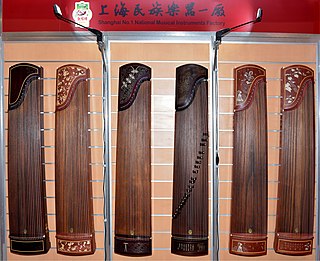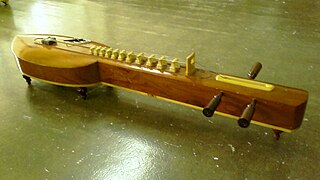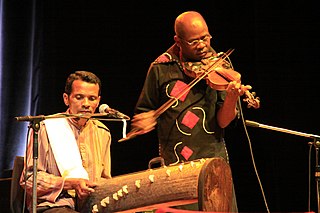
Zithers are a class of stringed instruments. Historically, it could be any instrument of the psaltery family. In modern terminology, it is more specifically an instrument consisting of many strings stretched across a thin, flat body, the topic of this article.

The highly diverse and distinctive music of Madagascar has been shaped by the musical traditions of Southeast Asia, Africa, Oceania, Arabia, England, France and the United States over time as indigenous people, immigrants, and colonists have made the island their home. Traditional instruments reflect these widespread origins: the mandoliny and kabosy owe their existence to the introduction of the guitar by early Arab or European seafarers, the ubiquitous djembe originated in mainland Africa and the valiha—the bamboo tube zither considered the national instrument of Madagascar—directly evolved from an earlier form of zither carried with the first Austronesian settlers on their outrigger canoes.

The zheng or guzheng, is a Chinese plucked zither. The modern guzheng commonly has 21, 25, or 26 strings, is 64 inches long, and is tuned in a major pentatonic scale. It has a large, resonant soundboard made from Paulownia wood. Other components are often made from other woods for structural or decorative reasons. Guzheng players often wear a fingerpick made from materials such as plastic, resin, tortoiseshell, or ivory on one or both hands.

A Sodina is a woodwind instrument commonly played in Malagasy music and a member of the aerophone family of instruments. Similar in structure and sound to a flute, the sodina is usually made out of bamboo, lightwood, plastic, or reed and varies in size depending upon the region it is being played in.
Traditional Vietnamese musical instruments are the musical instruments used in the traditional and classical musics of Vietnam. They comprise a wide range of string, wind, and percussion instruments, used by both the Viet majority as well as the nation's ethnic minorities.

The culture of Madagascar reflects the origins of the Malagasy people in Southeast Asia, East Africa and Oceania. The influence of Arabs, Indians, British, French and Chinese settlers is also evident.

The chakhe or krapeu also called takhe, is a fretted floor zither or lute with three strings used in Thai and Khmer music. The Thai and the Khmer instrument are virtually identical.

The marovany is a suitcase shaped, wooden, type of box zither from Madagascar, used in Malagasy music. It is strung on both sides with metal strings. The player plucks the strings with both hands, often with rapid alternation. This often creates complex rhythmic patterns, typical of Malagasy music. It is tuned in sequences of thirds. The instrument is commonly used in rituals and spiritual gatherings.

The sasando, also called sasandu from Sandu or Sanu, is a tube zither, a harp-like traditional music string instrument native to Rote Island of East Nusa Tenggara, Indonesia.

Bamboo's natural hollow form makes it an obvious choice for many musical instruments. In South and South East Asia, traditional uses of bamboo the instrument include various types of woodwind instruments, such as flutes, and devices like xylophones and organs, which require resonating sections. In some traditional instruments bamboo is the primary material, while others combine bamboo with other materials such as wood and leather.
The kulibit is a type of tube zither played by the Kalinga people of the Philippines. The instrument consists of a long tube of bamboo which has been slit to allow five or six strands of the bamboo husk to be played as "strings".
An idiochord is a musical instrument in which the "string" of the instrument is made from the same material as its resonating body. Such instruments may be found in the Indian Ocean region, disparate regions of Africa and its diaspora, and parts of Europe and North America.
The karaniing is a type of bamboo tube zither played among the Orang Asli tribal peoples of Malaysia.
The krem is a musical instrument, a type of bamboo tube zither played by the Jah Hut group of the Orang Asli tribal peoples of Malaysia.

The veena, also spelled vina, is any of various chordophone instruments from the Indian subcontinent. Ancient musical instruments evolved into many variations, such as lutes, zithers and arched harps. The many regional designs have different names such as the Rudra veena, the Saraswati veena, the Vichitra veena and others.
Justin Vali ranks among the greatest living players of traditional Malagasy music on the valiha, a bamboo tube zither considered the national instrument of Madagascar. He also performs on the marovany box zither of central and southern Madagascar. Vali contributed to several compilations in the late 1980s before beginning to release his own albums in 1990. In 1994 he recorded Ny Marina at Real World Studios under Peter Gabriel's Real World Records. In 1999 he released The Sunshine Within, a collaboration with Paddy Bush. In 2008 he collaborated with Eric Manana and other prominent Malagasy artists to record an album as the Malagasy All Stars. Vali resides in Paris and performs regularly on the international world music festival circuit, including performances on several continents with the WOMAD festival. In 2006 he was awarded the Grand Prize for Traditional Music by Société des Auteurs Compositeurs et Editeurs de Musique, the French songwriters' guild.
The ndzendze is a Comorian musical instrument, of the box-zither type, possibly derived from the Malagasy valiha. The musician Soubi of Mwali is recognized as a master of the instrument.

The kong ring or gung treng is a Cambodian tube zither, in which a tube of bamboo is used as a resonator for stings that run along the outside of the tube, lengthwise. It has the same musical purpose as the "bossed gongs" and may substitute for them and accompany singing. Although it is a traditional instrument with a long history, it has been improved on in modern times. The kong ring is represented by similar instruments in other countries of South Asia and the Pacific.
3MA is a contemporary African music group, consisting of three players of different string instruments: Ballaké Sissoko from Mali on kora, Driss El Maloumi from Morocco on oud and Rajery from Madagascar on valiha. The band takes its name from the first two letters of each member's country of origin in French: Madagascar, Mali, and Maroc.

The tube zither is a stringed musical instrument in which a tube functions both as an instrument's neck and its soundbox. As the neck, it holds strings taut and allows them to vibrate. As a soundbox, it modifies the sound and transfers it to the open air. The instruments are among the oldest of chordophones, being "a very early stage" in the development of chordophones, and predate some of the oldest chordophones, such as the Chinese Se, zithers built on a tube split in half. Most tube zithers are made of bamboo, played today in Madagascar, India, Southeast Asia and Taiwan. Tube zithers made from other materials have been found in Europe and the United States, made from materials such as cornstalks and cactus.













